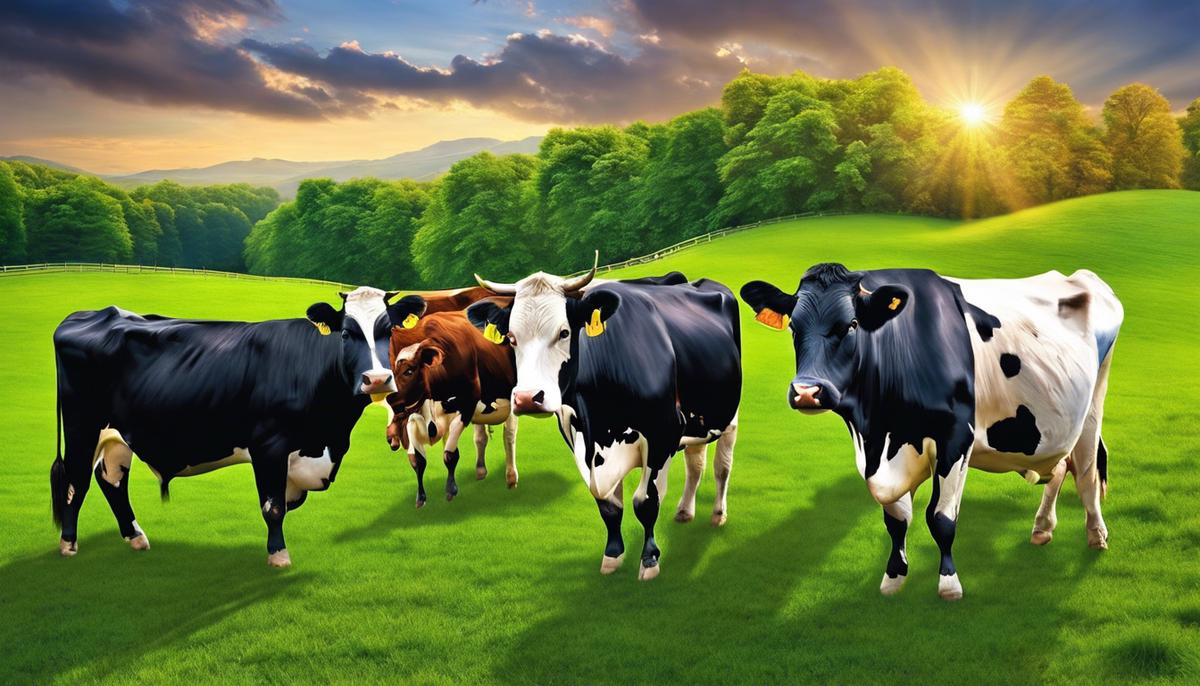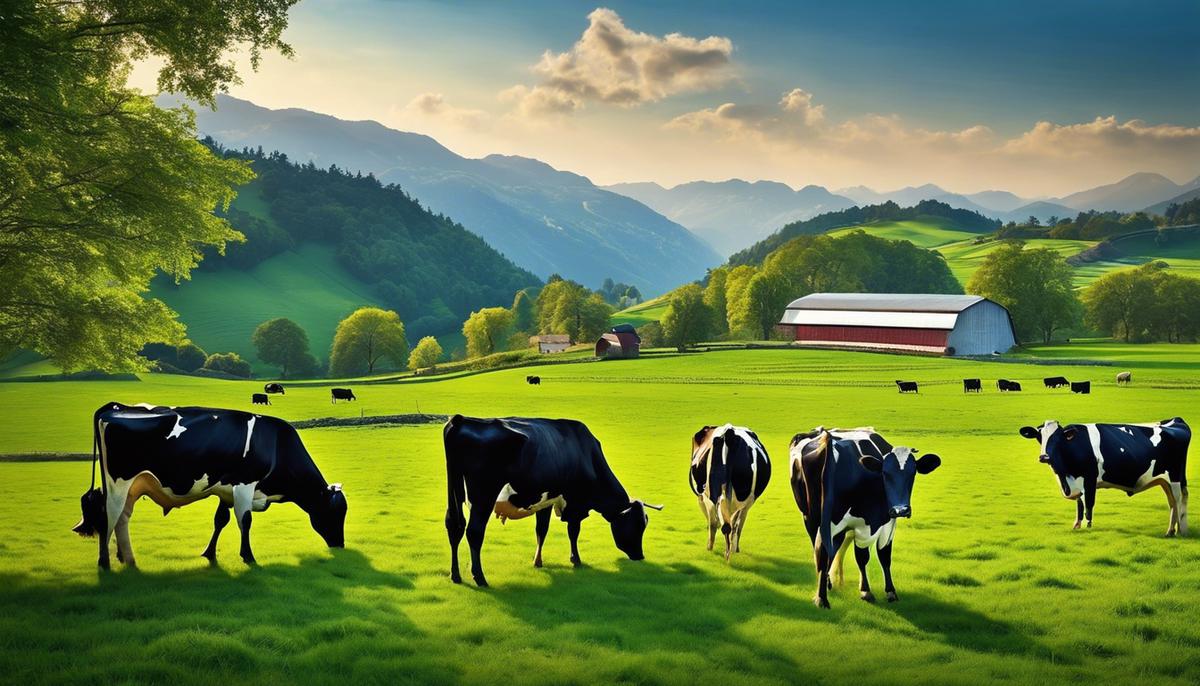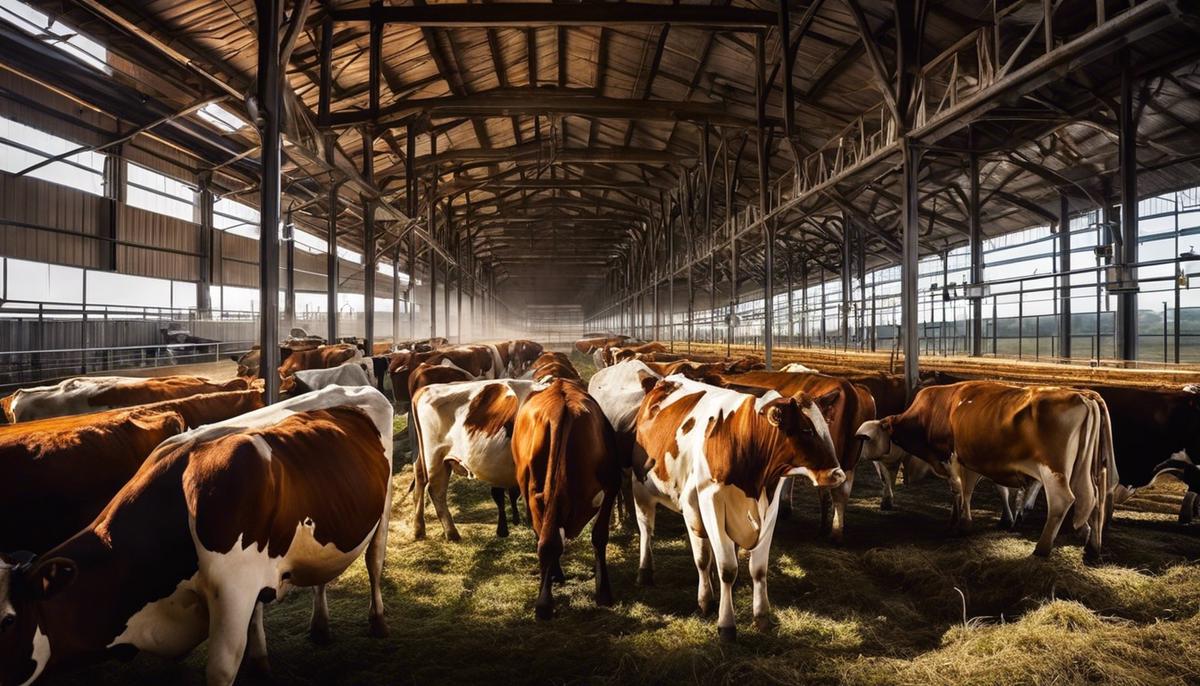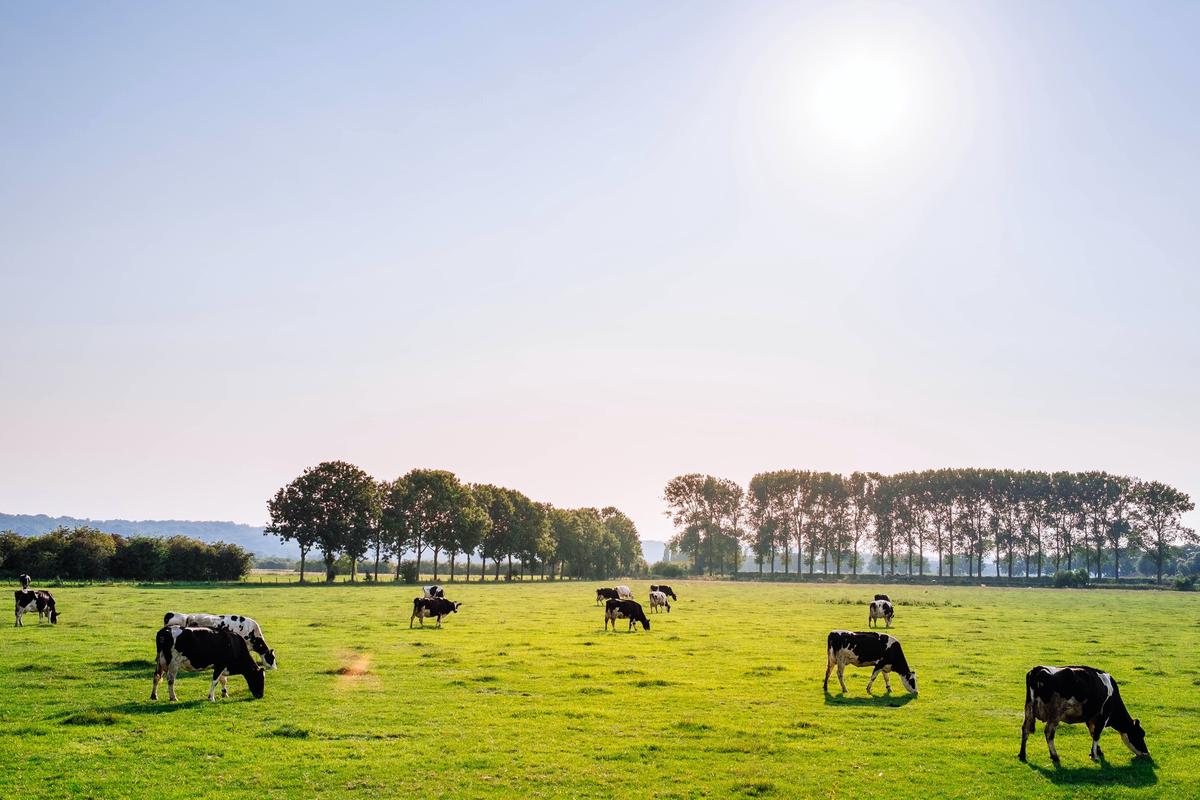

Agridisk
Egypt - Alexandria

Dairy cattle farming, Nutrition, Feed Management, Techniques & What is the basic concept of dairy cattle?
Description: Milk, an essential part of the daily diet for many, comes from our industrious dairy cows whose productivity fundamentally depends on diverse factors, ranging from their intrinsic biology to external inputs in the form of nutrition, farming techniques, and biosecurity measures. The physiology of these incredible creatures is intrinsically linked to their milk-producing capabilities, highlighting the reciprocal interplay between feeding management and the beneficial transformations it elicits within them. Furthermore, the methods and approaches in dairy farming not only influence milk yield but critically reflect on the quality of the product itself and the welfare of the animals. In an era gravitating towards sustainability, understanding the environmental footprint of dairy farming and the mitigating measures that can be employed is essential. With disease being a persistent threat to productivity, a robust biosecurity strategy presents an efficient front-line defense. As we unravel the multifaceted world of dairy cattle farming, we deepen our appreciation of the sources of our dairy delights, while continually encouraging practices that exhibit care for our cows and the environment. The intricate tapestry of dairy cow physiology plays a pivotal role in dictating milk production, warranting considerable attention and study in the field of animal science and dairy farming. As a fascia lata of interconnected systems, pathways, and mechanisms, the dairy cow's physiology represents an enigmatic territory that strides beyond the confines of nature nurturing life. Undeniably, one of the significant contributors to milk yield is the underlying metabolic process within the dairy cow's mammary glands. These glands represent an evolving microcosm where the exchange of nutrients, hormones, and growth factors commences, leading to the production of milk. A correlation manifests between the surface area of mammary gland epithelial cells and milk yield, thereby suggesting the potential benefits of genetic selection for improving milk output. Moreover, the intricate endocrine system of dairy cows serves as a central driver of milk production. It implicates a coterie of hormones such as growth hormone (GH), prolactin, and insulin that stimulate milk synthesis. Prolactin, released by the anterior pituitary gland during the lactation period, triggers milk production while GH, in synergy with insulin, is instrumental in routing nutrients towards the mammary gland. Nutritional intake substantively influences milk production and its constituents. The dairy cow's diet, rich in starch and crude proteins, not only fulfills the energy demands but also serves as a substrate for milk protein synthesis. Dairies promote an optimized ration balancing strategy to fulfill these nutritional requirements, ensuring a well-balanced diet for dairy cows. Additionally, rumen fermentation — a unique physiological characteristic of dairy cows — contributes to milk production. A symbiotic consortium of rumen microorganisms breaks down the dietary substances into volatile fatty acids and microbial proteins. These by-products become the primary energy source and protein supply for milk production, displaying the originality of bovine physiology. Lastly, the role of the reproductive system in milk production requires mentioning. Each cycle of pregnancy and calving in a cow’s life ushers a new lactation period, ensuring a continuous supply of milk. Lactation is, after all, a hormonally-mediated offshoot of reproduction. Ranging from the intricacies of cellular activities in the mammary glands to the synchronization of the endocrine system, dietary influence, rumen microbial activities, and the reproductive cycle, bovine physiology holds the reins of milk production. Such a profound realization underscores the need for a comprehensive understanding and scientific intervention in dairy cow management, not only to enhance milk output but also to ensure the welfare of these vital contributors to human sustenance. Without doubt, the nuanced understanding of the physiology of dairy cows prompts transformative innovation in animal husbandry practices that shape our dairy industry, strengthening the bridge between academic understanding and practical farming applications. In the realm of dairy science, optimizing the yield of milk production from dairy cattle stands paramount. Equally as significant is ensuring the welfare and health of the animal. The wheelwork that drives these two spheres, interestingly, is the science and art of crafting the right nutrition strategy. This finely tided equilibrium between top-notch milk production and animal welfare pivots on the understanding of what really fuels the milk machines — the right diet. Delving deeper into the dietary dimension for dairy cattle, it’s pivotal to understand that the anatomical and physiological characteristics of these bovines require a finely balanced diet that includes sufficient quantities of both concentrates and roughage. Focusing on this principle, evidence-based recommendations suggest that about 50-60% of the diet should consist of concentrates comprising primarily of grains, while the rest should comprise of roughage in the form of cheap and readily available straw. A key component of the concentrates include carbohydrates, both structural and non-structural, that act as the main energy source for these high-producing animals. They are fundamentally essential to meet the high energy demands of lactation, help enhance the intake of dry matter, and promote the optimal functioning of ruminal microbes to derive the maximum benefit from the consumed feed. In addition to carbohydrates, dietary protein also plays a crucial role in milk production, as it forms an indispensable building block in the synthesis of milk protein. The fine balance that needs to be treaded, however, is ensuring the right balance between degradable and undegradable dietary protein, so as to not only facilitate maximum milk production, but also ensure the nutrient efficiency and health of the rumen microbial population. A cornerstone that should not be overlooked when considering the dietary strategies is the vital role of minerals and vitamins in dairy cattle's diet. Macro-minerals like calcium and phosphorus are requisites in bone structure and milk synthesis, and their dietary proportion should be rationed optimistically for these functions. Trace minerals such as copper, selenium, and zinc exert a significant impact on the immune function, reproduction, and milk production. Fat-soluble vitamins such as Vitamin A, D, and E also play crucial roles in improving milk production quantity and quality. The challenge of genuine interest in this domain is not restricted to understanding what constitutes the right diet, but also revolves around deciphering how the diet should be formulated, presented, and consumed to invoke maximum benefit. Emphasizing the fundamentals of feeding, it's worth noting that regularity in feeding, offering fresh feed, and ensuring a consistent particle size can have a profound impact on feed intake, digestion, and, consequently, milk production. Taking the conversation further, nutrition strategies should not be designed in isolation and must always be complementary and synergistic with other management practices. Maintaining cows in a comfortable, stress-free environment, ensuring their optimal health, providing clean water, forming similarly productive groups for feeding, and maintaining a regular vaccination program should at all times go hand in hand with the nutritional strategy to succeed in the endeavor of maximizing milk production. The profundity and complexity involved in understanding the right nutrition strategies for dairy cattle is a testament to the incredible works of science that it embraces. It's a journey that demands unraveling the intricate connections woven between the animal, its diet, its environment, and the production of its milk – a challenge that, when embraced with the right knowledge and intention, can lead to incredulous strides in the dairy science and industry. Expanding the scope of this academic exploration, dairy farming practices also encompass several integral elements that harmonize to create high-quality milk production. These contemporary dairy farming techniques revolve around optimized barn architecture, advanced milking systems, breeding strategies, and more meticulous management of animal health. A remarkable evolution in cow shed designs and structures reflects a fine balance between practicality and comfort for the livestock. They aim to provide dairy cows with an optimal living environment to significantly reduce stress levels, promote their well-being, and increase milk yield. Such designs include mechanically ventilated sheds and freestalls, underlining the importance of cow comfort as a critical precursor to their productivity. Advanced milking systems, like automated rotary parlors, warrant a variety of benefits directly impacting milk yield and quality. These systems streamline the milking process, reduce the labor required, and incorporate technology to monitor udder health and milk quality efficiently. For instance, some parlors feature technology that can detect abnormal milk conductivities, a possible indication of mastitis infection, thus preventing compromised milk from entering the food chain. Holstein Friesians may rule the industry for their unsurpassed volumes, but a subtler push towards breeding strategies is emerging. These programs aim to create cows that consistently yield high-quality milk with desired traits – such as the optimal fat and protein content. Genomic selection accelerates the pace of securing these traits, prompting an opportunity to exalt the genetic potential in dairy herds. Moreover, sound management of animal health cannot be underestimated for both ethical and productivity reasons. Regularly scheduled veterinary check-ups and vaccination programs stave off potential diseases that can negatively impact milk production. Additionally, mastering the skill of detecting heat (estrus) in cows is essential to steer the course of successful breeding programs. To further boost productivity, attention to the dry period is vitally important. This crucial non-lactating phase allows cows to regenerate their udder tissue for the next lactation. Proper management practices in this period, including appropriate nutrition and rest, can significantly influence the subsequent lactation's milk yield and quality. In conclusion, a systematic intertwining of various dairy farming techniques harmonizes to stimulate milk yield and quality. Each practice, in its way, contributes to the larger picture of successful and ethical dairy farming. Indeed, it is through the profound study and understanding of these practices, which have emerged from extensive research and field trials, that one can unlock the fullest potential in a dairy operation. And while we continue to deepen this understanding, it is fair to say that the pursuit of knowledge in this field remains as fertile and promising as the first day. Widening the lens from specific farming practices, one must consider the greater environmental impacts intrinsically tied to all facets of dairy farming. It is vital to recognize the profound effects dairy farming can have on numerous environmental aspects including, but not exclusive to, greenhouse gas emissions, land use, water usage, and loss of biodiversity. Greenhouse gas emissions from dairy farming chiefly include methane, nitrous oxide, and carbon dioxide. Primarily, methane is emitted from enteric fermentation in the rumen and manure management. Being a potent greenhouse gas, methane significantly contributes to global warming. Nitrous oxide, another potent greenhouse gas, is predominantly released through manure and urine contacting soils and oxygen. Carbon dioxide is also released through feed production, processing, on-farm energy use, and dairy product transport, often underlining the global footprint of each gallon of milk. Land use for dairy farming extends beyond the space required for the livestock. It encompasses the land area required to grow fodder crops as well. Notably, it is estimated that 80% of the world’s soy crop is used as animal feed, indicating that large-scale deforestation, particularly in the tropics, is directly linked to dairy farming. The water footprint of dairy farming is also considerable. This encompasses the water consumed by the cows, that which is used for cleaning and sanitation processes, and the water used in cultivating feed crops. For context, it is estimated that nearly 1,000 liters of water are required to produce just 1 liter of milk. Furthermore, the overuse of antibiotics in dairy farming can lead to antimicrobial resistance, a global health issue that jeopardizes the effectiveness of ensuring effective treatment for an increasing range of infections. However, opportunities abound for making dairy farming more sustainable. Notably, transitioning to more sustainable feed sources, such as using locally sourced, less resource-intensive, or crop-byproduct-based feedstocks, promises to reduce both the methane emissions and the water footprint of dairy farming. Manure management is another area ripe for improvements. Anaerobic digestion systems can convert manure into biogas for generating electricity, reducing reliance on fossil fuels. Moreover, investing in precision farming technologies can lead to further resource efficiencies. Advanced sensors and analytics technologies can aid farmers in making more informed decisions about how to allocate resources like feed, water, and veterinary care, thereby improving overall productivity and environmental impact. Furthermore, adopting agroforestry or silvopasture systems can offer immense benefits. This involves integrating trees and shrubs into animal farming, hence increasing biodiversity, reducing soil erosion, and improving carbon sequestration. In conclusion, a collaborative, science-driven approach to sustainability in the dairy sector, coupled with policy-level action and consumer demand for sustainable products, has the potential to catalyze meaningful progress towards reliability, renewability, and environmental longevity. This not only promises sustainability on the farm but also ushers the opportunity to nurture a healthier planet. Biosecurity, a concept initially developed to thwart the propagation of harmful organisms in the field of public health, has a profound influence on health and productivity in dairy cattle farming. Whether it's a small homestead milking a few cows or a large commercial dairy unit milishing hundreds or thousands, prioritization of biosecurity measures can inhibit the introduction and spread of infectious diseases, consequently improving cattle health, productivity, and welfare. Pathogens in dairy farming are introduced by various vectors, including other cattle, non-bovine animal species, people, equipment, feed, and water. An effective biosecurity plan is quintessential to minimize these risks. Importing new animals, the most common route of disease entry into a dairy herd, necessitates a rigorous quarantine period, ideally separate from the main herd for a minimum of two weeks. Importantly, incoming animals should undergo comprehensive health screenings for diseases common in the region. A robust disease surveillance system that can early detect and diagnose diseases is also crucial. Resources should be invested in regular testing for diseases like bovine tuberculosis, paratuberculosis, bovine viral diarrhoea (BVD), leptospirosis, and others. Infected animals should be promptly isolated and treated. The role of good husbandry practices cannot be overstated. Keeping the animals, and their environment clean and disinfecting the equipment used can drastically reduce the disease burden. Utilizing separate equipment for diseased and healthy animals or disinfecting after every use can inhibit transmission. Notably, many infectious diseases affecting dairy cattle are zoonotic, meaning they can be transmitted to humans. Staff members in contact with the animals should therefore be adequately trained in biosecurity protocols and given necessary protective equipment. Implementation of vaccine programs, especially for diseases where effective vaccines are available, should also be a component of a biosecurity plan. Apart from reducing disease spread, biosecurity measures can also greatly influence productivity by improving udder health and reducing mastitis, a significant factor impairing milk production. Mastitis, the inflammation of mammary glands, often caused by bacteria, severely hampers milk yield and quality. Effective biosecurity measures, coupled with optimal milking practices, can dramatically reduce mastitis incidence, thereby improving milk output and quality. Control of external and internal parasites is another attribute of biosecurity. Parasitic infections can lead to loss of appetite, weight loss, reduced milk production, and in severe cases even death. Routine control measures, including regular fecal testing, and taking necessary steps for infestation based on individual or herd basis, are salient. Apart from improving productivity, implementing robust biosecurity measures will also promote animal welfare. Cattle in disease-free, clean environments are typically less stressed, leading to improved immune function, reproduction performance, and overall well-being. To sum up, biosecurity in dairy farming is not an option but a necessity. Proactive and effective biosecurity measures reduce disease incidence, improve productivity and animal welfare, and provide dairy products that are safe for human consumption. It's a shared responsibility of the dairy farmers, veterinarians, and the entire dairy community. The importance of tailoring biosecurity protocols to individual farms and their specific circumstances, risk factors, and resources is paramount. As the saying goes, prevention is always better than cure. In this context, biosecurity is the path to achieving this goal. Also, the exploration of dairy cattle farming has unfolded the intricate tapestry of diverse factors that govern the production of milk, a dietary staple for many. It has underscored how the nutrition and farming techniques can directly enhance cow’s wellbeing and in turn, augment milk production. Deeper insights into cow's physiology further help us engineer better means to foster their productivity. Substantially, environmental sustainability practices are the need of the hour that not only reduce farming's ecological footprint but carve the path for a balanced coexistence of agriculture and biodiversity. Moreover, effective biosecurity practices effectively support the health and productivity of dairy farms, safeguarding the milk supply for populations. As our understanding and practices in dairy farming evolve, so shall our ability to ensure healthier cows, yield a richer product, and foster a greener planet.Dairy cattle farming, Nutrition, Feed Management, Techniques & What is the basic concept of dairy cattle?
Dairy cattle farming, Nutrition, Feed Management & Techniques
Physiology of Dairy Cows
Unraveling Bovine Physiology: A Deeper Dive into Dairy Cow Milk Production

Nutrition and Feed Management in Dairy Farming
Harnessing the Power of Optimal Nutrition Strategies to Maximize Milk Production in Dairy Cattle

Dairy Farming Techniques

Environmental Impact and Sustainability in Dairy Farming

Biosecurity in Dairy Cattle Farming

What is the basic concept of dairy cattle?
The vast expanse of dairy farming embodies an intricate tapestry that intricately weaves together the threads of physiology, breeding, welfare, and sustainability. At the heart of this agricultural sector are dairy cattle, remarkable creatures whose lives are governed by a complex system of biological processes. This essay ventures into the realm of these majestic animals, shedding light on the physiological intricacies that sustain their health and productivity. From the detailed study of bovine anatomy to the essential nutrients that fuel lactation, we examine the mechanisms that make dairy cattle so integral to our food supply. Moreover, we delve into the genetic mastery and breeding insights that aim to elevate milk production to its zenith. Simultaneously, we recognize that the vitality of the dairy sector hinges not only on productivity but also on the welfare of these sentient beings, necessitating a balance that melds ethical stewardship with technological advancements toward a sustainable future.
The path to augmenting dairy production is intrinsically connected with a profound comprehension of cattle physiology. The mammary gland function, for instance, serves as the cornerstone of milk synthesis and secretion. Through meticulous observation and empirical research, we have ascertained that optimizing feed composition, based on the intricate understanding of ruminant digestive metabolism, leads to marked improvements in milk yield and quality. When the bovine diet is carefully balanced with regards to energy, protein, and fiber, the digestive system operates at peak efficiency, which in turn enhances the metabolic processes that furnish the precursors for milk production.
Furthermore, the significance of monitoring reproductive health and managing stress factors is paramount. The endocrine system, which regulates hormonal balance, is exceedingly sensitive to external stimuli. By mitigating stressors through environmental control and humane handling practices, one can ensure that the hormonal milieu is conducive to higher fertility rates and, consequently, superior lactation cycles. There is also burgeoning evidence that genetic selection for traits like milk protein and fat percentage can lead to herds that are not only more productive but also more resilient to common dairy health challenges.
In essence, an erudite understanding of these physiological principles is indispensable for the advancement of dairy operations. Rigorous scientific endeavors continue to unravel the multifarious aspects of bovine biology, thereby equipping dairy producers with actionable knowledge to refine their practices and actualize the full potential of their herds. Without question, the future of dairy production is reliant upon the symbiosis between bovine physiological expertise and applied dairy management strategies.

Ensuring the welfare and sustainability of dairy farming extends beyond nutritional and reproductive management; it is imperative to integrate comprehensive healthcare protocols and environmental stewardship in these practices.
A critical component of dairy herd healthcare is the prevention and prompt treatment of diseases, including mastitis, lameness, and respiratory conditions. Such ailments not only compromise animal well-being but also lead to significant economic losses through decreased milk production and increased veterinary costs. To tackle these issues, regular health monitoring and record-keeping become essential. Tailoring vaccination schedules, parasite control programs, and regular hoof trimming are all practices that optimize the well-being of the herd, consequently contributing to sustainable dairy farming operations.
Environmental sustainability is another cornerstone of progressive dairy farming practices. The notion of a farm's carbon footprint is of increasing concern, and as such, strategies to reduce greenhouse gas emissions are imperative. Methane is a potent greenhouse gas, and ruminants are known for their methane production; however, innovative methods, such as the incorporation of dietary additives that inhibit methane production, are being explored and implemented. Additionally, manure management plays a crucial role; converting waste into compost not only reduces environmental impact but also provides an alternative source of fertilizer. Lastly, water conservation techniques, along with protection of local waterways from potential contaminants, must be prioritized to ensure both the health of the ecosystem surrounding the farm and the long-term viability of the dairy industry itself. Embracing these best practices will contribute to the sustainability of dairy farming while maintaining the welfare of the animals, therefore continuing to meet the global demand for dairy in a responsible manner.

Embarking on a journey through the multifaceted world of dairy farming has revealed the entwined layers of animal physiology, conscientious breeding practices, and the pivotal role of welfare and sustainability. As stewards of these diligent providers, our responsibilities transcend beyond the immediate demands of production to encompass a broader vision of harmonious coexistence and respect for the natural world. The insights and strategies discussed herein are guideposts, leading us toward a resilient and ethical dairy industry that honors the profound contribution of dairy cattle, all while nurturing the land that supports them and securing the well-being of future generations. This enduring commitment to innovation, compassion, and environmental stewardship is the cornerstone upon which the longevity and prosperity of dairy farming can, and must, be built.